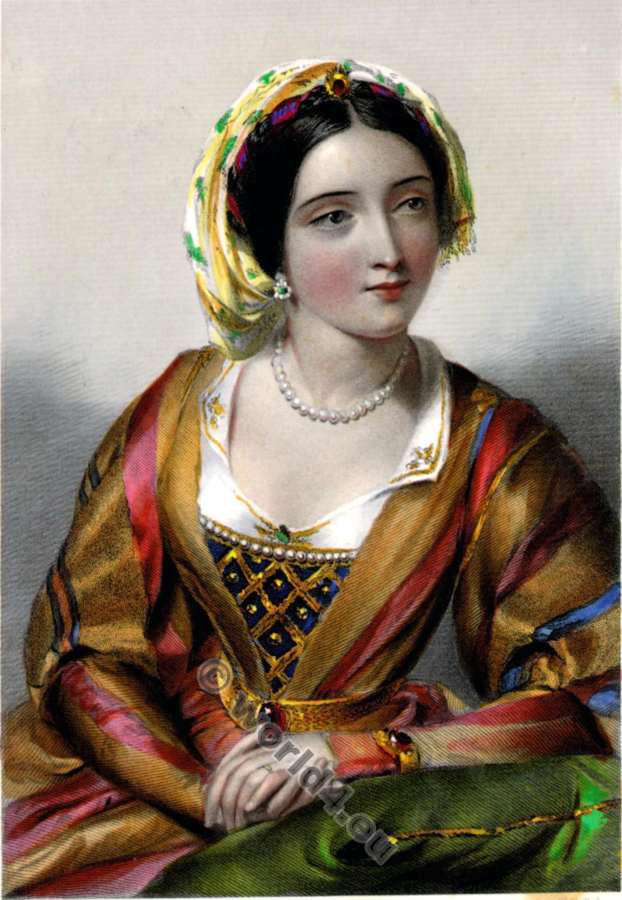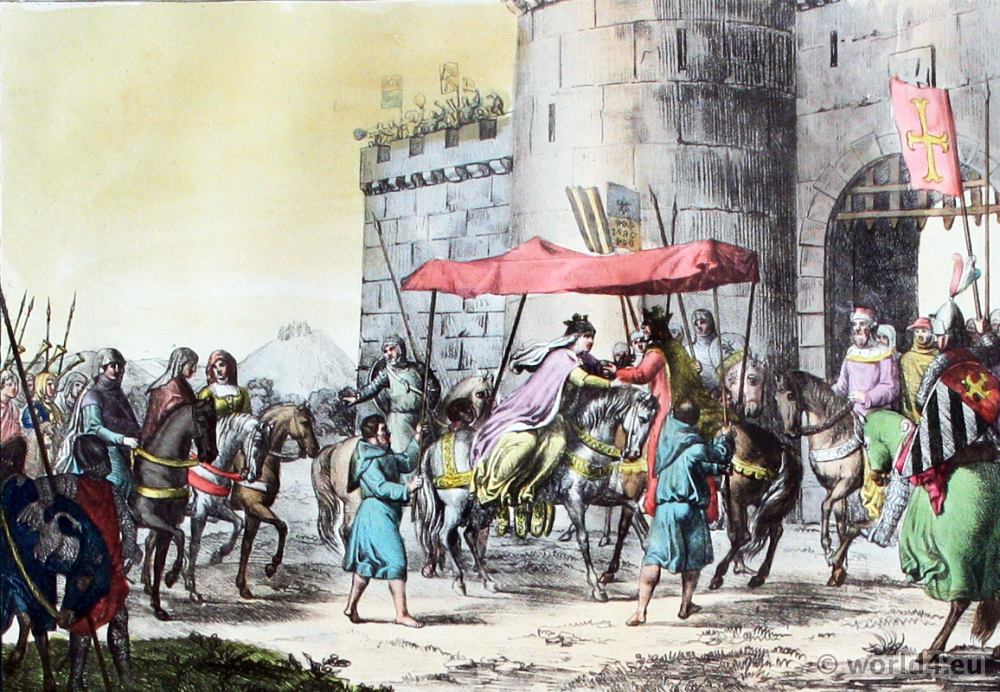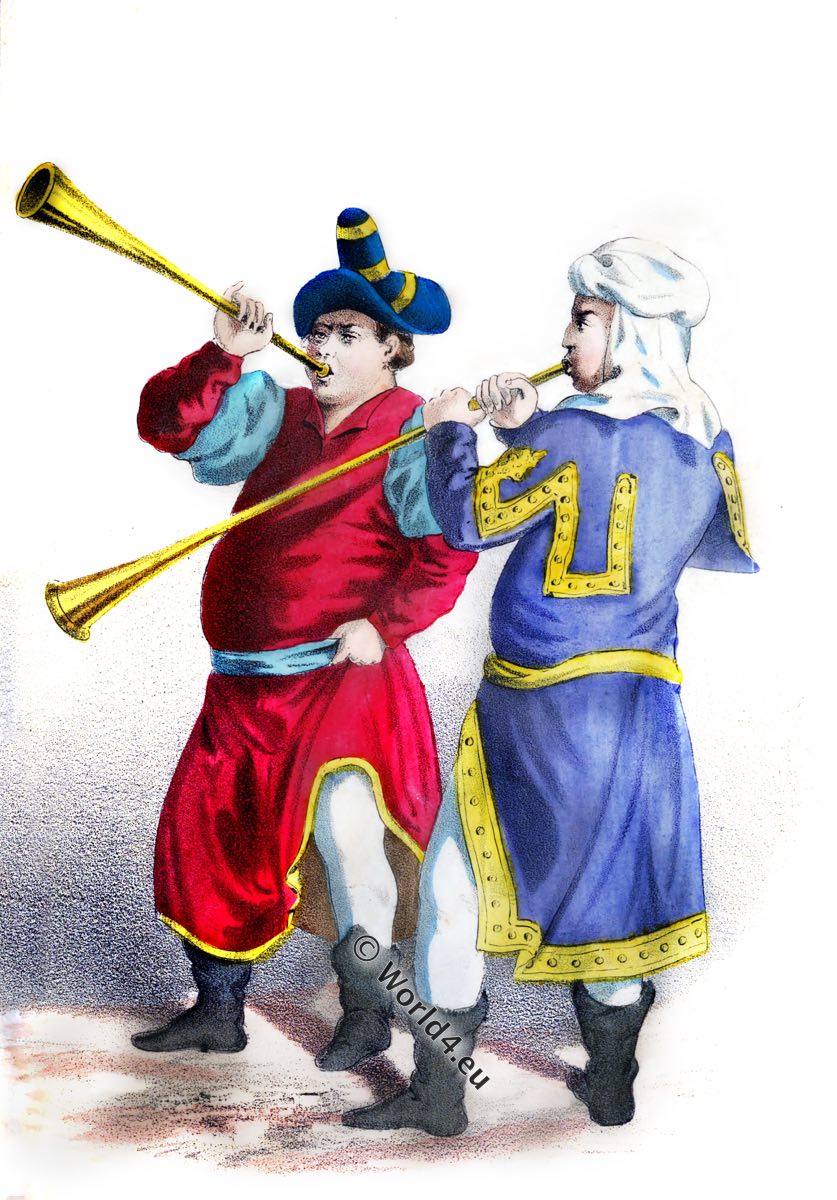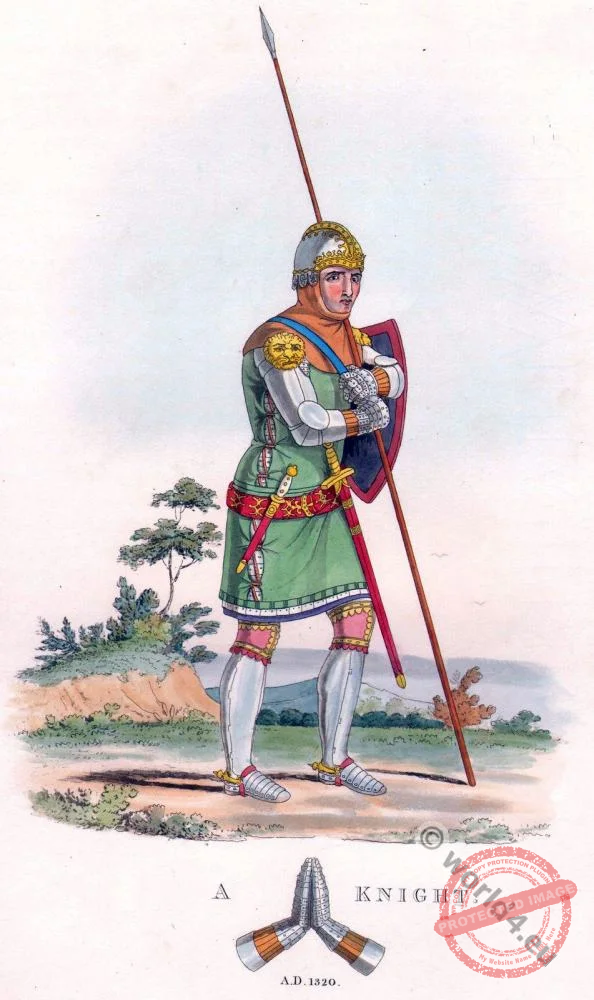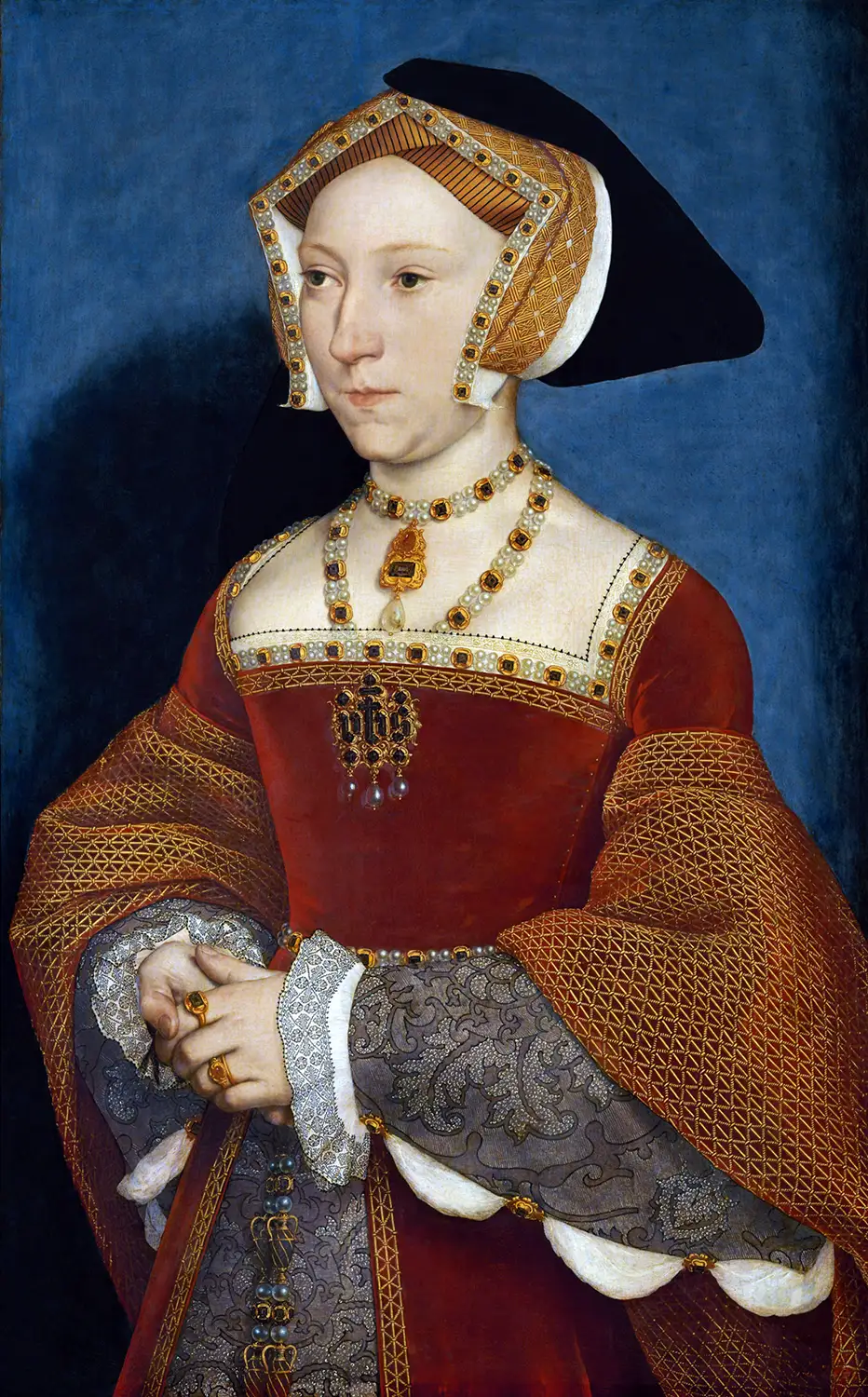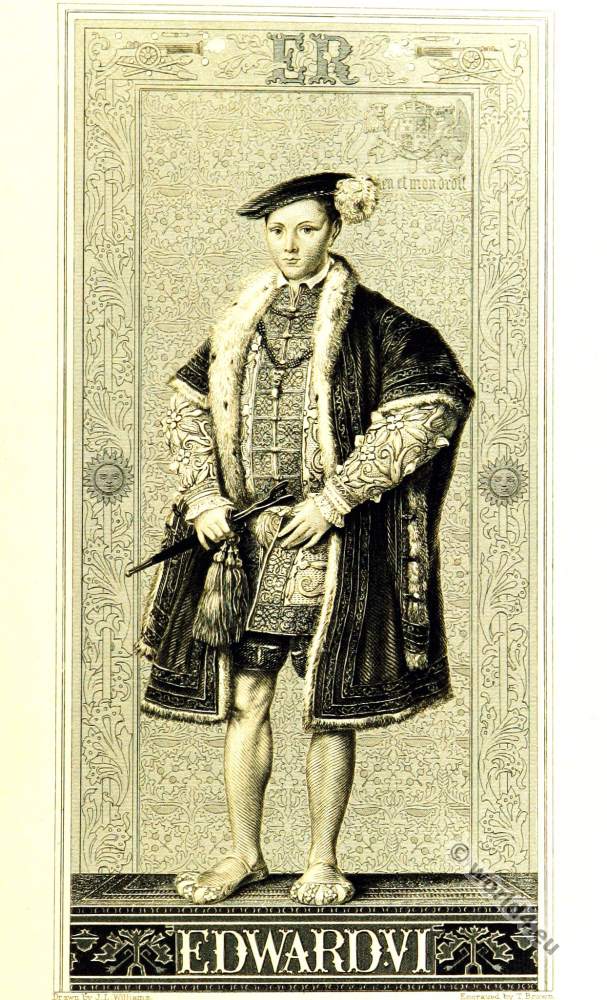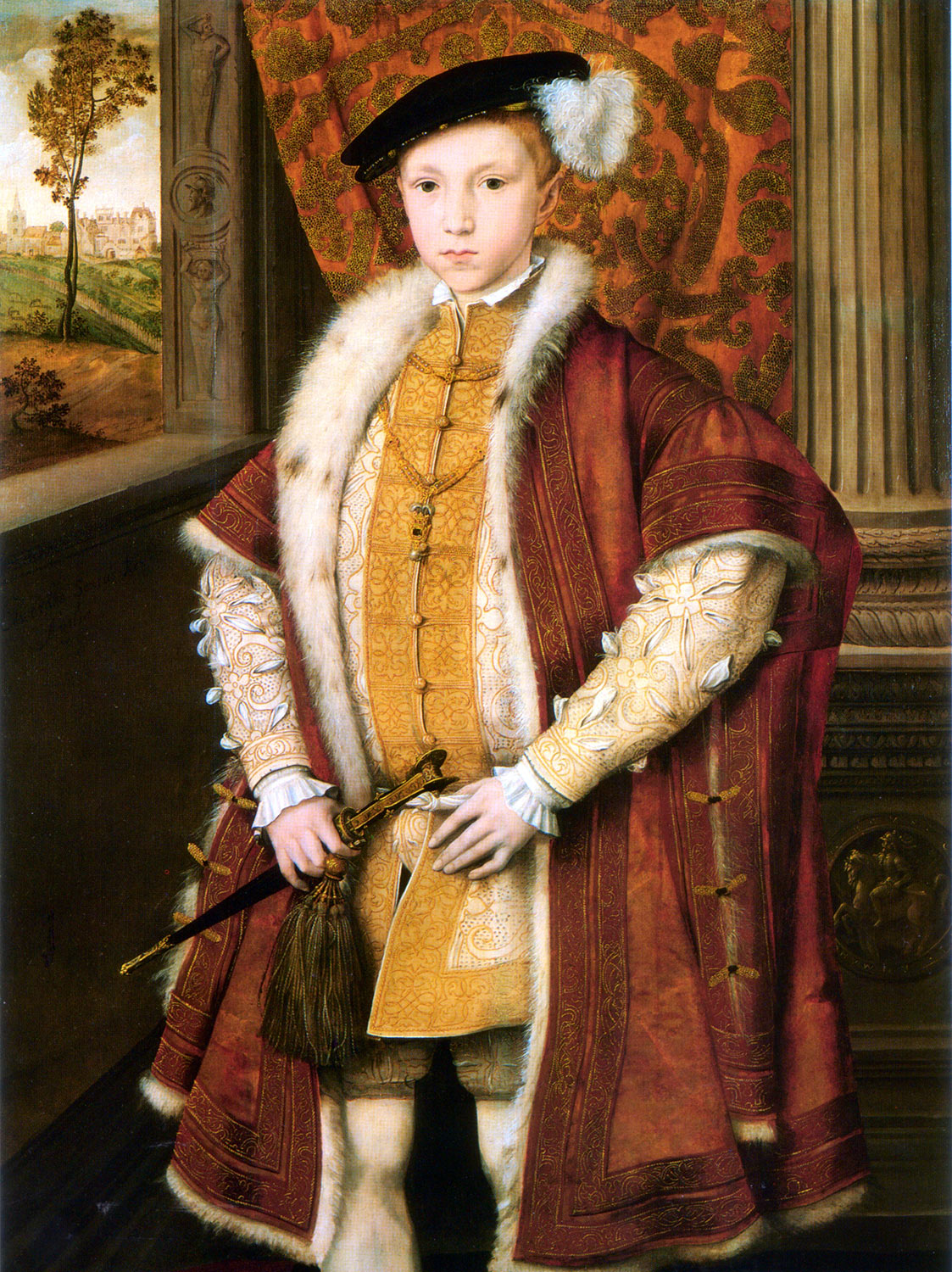Eleanor of Castile, first Queen of Edward the First.
Eleanor of Castile (also Leonor, 1241 – † 28 November 1290 in Harby, Nottinghamshire) was the first wife of King Edward I. Royal Consort of England.
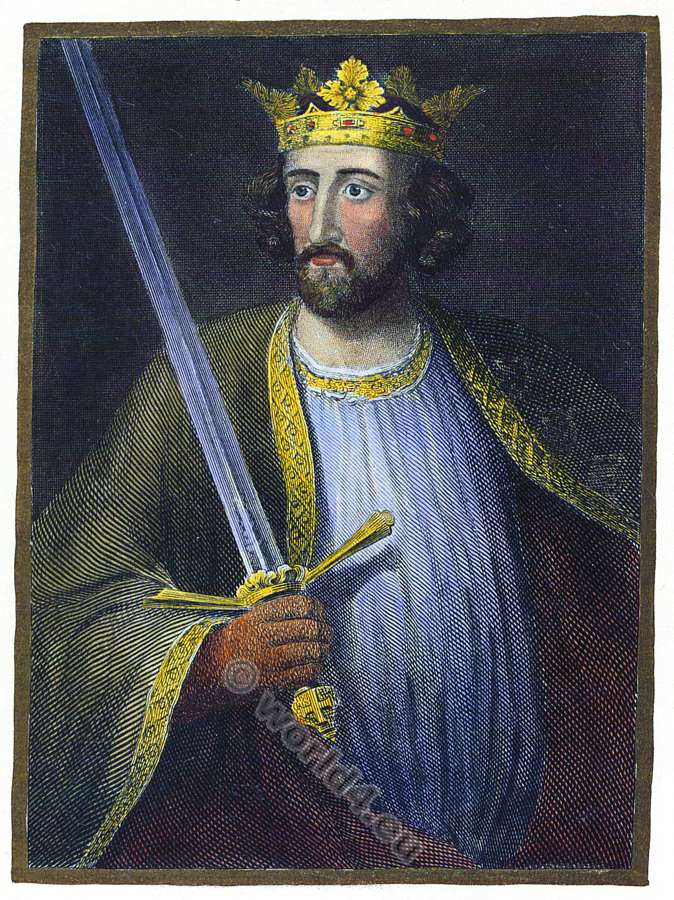
Monuments
Among the monuments to departed kings and queens which surround the ruined, but still magnificent, mausoleum of Edward the Confessor, in Westminster Abbey, there are two altar-tombs in particular, which recall a host of romantic associations, at which the stranger dwells the longest, and which are the last to fade from his memory.
The first, which is of considerable size, is of gray unpolished marble—massive, unornamented, and simple almost to rudeness; looking like, what in reality it is, the sarcophagus of a warrior-king. But how can we find language to describe the surpassing beauty of the other!
On a cenotaph of Petworth marble, and under a rich Gothic canopy, reclines a female figure of copper-gilt, habited in the graceful costume of the thirteenth century. “There it lies, not a feature of the face injured—not a finger broken off —perfect in its essentials as on the day it left the studio; whilst, all around, marks of injury and dilapidation meet you. on every side; it is as though its own serene beauty had rendered violence impossible—had even touched the heart of the great destroyer Time himself.” How easy and how dignified is the attitude of the recumbent figure ! How elegant the hands! How gracefully, from under the regal diadem, the long dresses fall on the rounded shoulders.
The countenance, too, which is represented as serenely smiling, is one of angelic loveliness, breathing eloquently of that feminine softness of character and purity of heart which were the characteristics of its living original. The former tomb is that of the great warrior, Edward the First; the other that of his beautiful and affectionate consort, Eleanor of Castile,—of her
“Who, like a jewel, did hang twenty years
About his neck, yet never lost her lustre;
Of her, that loved him with that excellence
That angels love good men with.”
Eleanor, daughter of Ferdinand the Third, King of Castile, by Joanna, Countess of Ponthieu, was born about the year 1244. She could scarcely have entered on her eleventh year when she was demanded in marriage by Henry the Third, King of England, for his eldest son, Prince Edward, then a youth of fifteen. The consent of her brother Alphonso, the reigning King of Castile, having been readily obtained, it was agreed by the contracting parties, that within a stipulated time the young prince should proceed, with his mother, Eleanor of Provence, to Burgos, the capital of Old Castile, in order to be united to his almost infant bride.
Rapin, who wrote in 1725, informs us that in his time the scroll, sealed with gold, in which Alphonso gave his written consent to the union of his sister with the Prince of England, was still preserved in the Chapter House at Westminster.
Henry the Third
At this period, Henry the Third was holding his court at Bourdeaux, from which place the young prince and his mother crossed the Pyrenees to Burgos, which city they reached on the 5th of August, 1254.
Their arrival in the Castilian capital was celebrated with all those circumstances of gorgeous magnificence which were the characteristics of the middle ages; and for several weeks the fine old city of Burgos was the scene of successive tournaments and festivals. It was on one of these occasions that Prince Edward was dubbed a knight by his royal brother-in-law.
Queen Eleanor was so delighted with her visit, that she remained there till the summer of the following year, when she recrossed the Pyrenees, accompanied by her son and his infant bride, and rejoined her husband, King Henry.
Christmas at Bourdeaux
King Henry kept his Christmas at Bourdeaux, where— determined not to be surpassed in magnificent hospitality by the Castilian monarch—he celebrated the espousals of his son and daughter-in-law with a splendor entailing such lavish expenditure as to draw down upon him the indignant outcries of his English subjects. “The King,” says Daniel, “consumed all his treasure in these journeys, which was reckoned at two hundred and seventy thousand pounds; more than all the lands which he had in those countries were worth, had they been sold right out; which, when he was told of, he desired it might not be published to his disgrace.”
King’s expenses
Matthew Paris places the king’s expenses at the same enormous amount. He also tells us that when one of his confidential advisers remonstrated with him on his extravagance, Henry retorted, with his accustomed oath— “For the head of God, say no more of it, lest the very relation make men wonder, and stand amazed.”
From Bourdeaux the royal family of England, attended by a numerous calvacade, proceeded homewards by way of Paris, where, on their arrival, they were lodged by King Louis in the Palace of the Temple, which had recently been built. Occupying this vast building, Henry endeavored to outvie the French monarch in the number and splendor of his entertainments.
Feast of Kings
One festival in particular is recorded, which was so magnificent as to obtain for it the distinguishing title of the “Feast of Kings;” the Kings of Scotland, France, and Navarre being present. There appears to have been an amicable contention between the two former sovereigns which should force the other to occupy the place of honor at the banquet. It ended, however, by Henry firmly insisting on his own inferiority; alleging, that being compelled to do homage to the French king for the territories which he held in his dominions, he could regard him in no other light than his sovereign.
Prince Edward
In consequence of their youthful age, it was not till several years after their espousals that Edward was allowed to consummate his marriage with his lovely bride. For about two years the princess seems to have continued in England; but, in 1256, Prince Edward passed over with her to Bourdeaux, where she continued probably under the care of some of her relatives of France, or of her mother-in-law, till 1265; and while she there was completing her education, Edward was traveling and practicing knightly exercises.
We find Prince Edward, then in his twenty-second year, distinguishing himself at jousts and tournaments at the different European courts; nor was it long afterwards that the fierce struggle between his father and the barons recalled him to England to discharge his filial duties, and to take a prominent part in the sanguinary fray.
In 1265, Edward met his wife at Dover, where she landed, under the care of his mother, from France. When Edward pressed the cheek of his bride, she was still a mere child, and he himself was unknown to fame.
When they now met, she stood before him in the full bloom of beauty and womanhood; nor, on his part, had he rendered himself undeserving of the fair hand and affectionate heart which he came to claim. Since they had last parted, he had earned for himself undying laurels.
Young as he was, he had won the reputation of an accomplished warrior ; and he now stood before her—worthy even of the love of Eleanor of Castile—in the proud light of the restorer of his father’s rights—the champion of his haughty race—the gallant victor of Evesham! The events which had taken place in the interval between their separation and reunion may be related in a few words.
Arrival in England
On his arrival in England, the young prince had the misfortune of finding his father a mere cipher in the hands of the “twenty-four barons,” who had usurped the sovereign power, and who, having formed an association among themselves, had sworn to stand steadfastly by each other at the hazard of their lives and fortunes. So absolute was their power that Edward found himself compelled to take the famous oath,—which was likewise imposed on all the king’s subjects under penalty of being declared public enemies,—that he would obey and execute all the regulations, both known and unknown, of the twenty-four barons; and all this, as it was jesuitically stated, for the greater glory of God—the honor of the church—the service of the king-and the advantage of the kingdom.
Guilford Castle
In proportion, however, to their continuance in power, the barons began gradually to lose that popularity to which they owed their rise. It became but too evident that, in investing themselves with the sovereign power, their object was far less the reformation of the state than the aggrandizement of themselves and their families; and, moreover, their power being daily weakened by their own intestine jealousies and animosities, the young prince, determined to seize the first opportunity of striking a bold stroke, which he hoped would restore his father to the authority which they had usurped from him.
Fortunately, the pope was as little satisfied with the conduct of the twenty-four barons in ecclesiastical affairs as were the people of England themselves; and accordingly, with little difficulty, he was prevailed upon to absolve the prince, as well as the whole of the king’s subjects, from the oath of obedience which they had taken to the barons. Thus once more left a free agent, Edward took off the mask, and boldly challenged the authority of the barons. The result is well known.
Civil war
The horrors of civil war were again renewed, and, after a variety of successes, disasters, and negotiations— in which fortune, as usual, shifted her smiles from one side to the other—the two opposing armies met on the memorable field of Evesham; the royal forces being commanded by Prince Edward, and those of the barons by the celebrated Simon de Montfort, Earl of Leicester.
This nobleman had encamped his army at Evesham, where he was anxiously expecting the arrival of his son, Simon de Montfort, to whom he had sent directions to hasten to him by forced marches, with all the troops he could render available. Accordingly, De Montfort was hurrying to the relief of his father, when, at Kenilworth, he was suddenly surprised and attacked in his camp by Prince Edward, who he had imagined was directing his whole force and attention against the Earl of Leicester at Ever-ham.
The success of the prince was complete; the opposing army was scattered in all directions, and the Earl of Oxford, and several other noblemen, were taken prisoners, almost without a show of resistance. Edward lost no time in improving his advantage, and this by adopting a very ingenious stratagem.
Without allowing Leicester time to glean intelligence of his son’s disaster, he divided his troops into two bodies, one of which he pushed forward along the road leading from Kenilworth to Evesham, with orders to carry in front of them the banners captured from De Montfort’s army.
He himself made a circuit with the other division of his forces, with the intention of attacking the enemy in another quarter. Leicester, experienced and accomplished as he was in the art of war, was completely deceived and taken by surprise.
Observing a large force advancing from the very quarter from which he was anxiously straining his eyes to behold the approach of his son—perceiving, also, the friendly banners, the sight of which was so welcome to him—his only feelings were those of satisfaction at his orders having been so successfully and promptly obeyed.
When at length the truth flashed upon him, and he perceived the great superiority and excellent disposition of the royalists, his first feeling seems to have been admiration of the talent by which he was outwitted. They had learned, he said, the art of war from him; and he added: “The Lord have mercy on our souls, for I see our bodies are the prince’s!” The conflict lasted but a short time, and was attended with great slaughter.
Leicester himself, while in the act of asking for quarter, was slain in the heat of the action; as were also his eldest son, Henry, Hugh le Despencer, and about one hundred and sixty knights, and many other gentlemen.
Henry the Third
The old king, Henry the Third, who for some time has been a prisoner in the hands of the rebels, had been purposely placed by them in front of the battle, and being completely clad in armor, it was impossible for his friends to identify him. In the heat of the action he received a wound, and would in all probability have been killed, had not he called out— “I am Henry of Winchester, your king!” Fortunately, his voice was recognized by his friends, and his gallant son having flown to his rescue, he was soon conducted to a place of safety.
Battle of Evesham
The battle of Evesham took place on the 12th of August, 1265, and, two months afterward, on the 29th of October, the young princess arrived in England with her mother-in-law, Eleanor of Provence. She landed at Dover, where she was received by her gallant lord, who conducted her not improbably to the same apartment in Dover Castle to which, exactly four hundred years afterwards, his unfortunate successor, Charles the First, led his fair bride, Henrietta Maria, after her arrival at Dover; and where, “wrapping his arms around her, he kissed her with many kisses.”
From Dover, Edward escorted his bride to Canterbury, where they were entertained with great splendor by the archbishop. They then continued their progress to London, where the citizens celebrated their arrival with all kinds of pageants and rejoicings.
Having, in the first instance, been lodged in the priory of St. John’s, near Smithfield, they afterwards took up their abode in the magnificent palace of the Savoy, in the Strand, which had recently been granted by Henry the Third to Peter of Savoy, uncle to his queen, Eleanor of Provence. The following year the young princess was delivered of her first-born, John, at Windsor Castle.
The Holy Land
Much as the original character of Edward the First has been eulogized, the truth of history forbids us to represent him at this period’ of his life as faultless. On the contrary, during his young wife’s abode in France, his intrigue with the Duchess of Gloucester involved the whole court in broils and dissensions, which did not cease till 1270, when he and the princess left the court, to proceed to Palestine.
Eleanor had been married about four years, when her warlike husband, panting to signalize himself once more in the field of arms, expressed his determination to take up the cross, and, with the aid of Louis, King of France (commonly known as St. Louis), to make a grand simultaneous effort to expel the infidels forever from the Holy Land.
It was a campaign which threatened danger and death, in a variety of shapes, even to the strongest and boldest; how little suited, therefore, was a young and delicate princess, nurtured in the lap of luxury, to encounter its hardships, its horrors, and its fatigues!
So devoted, however, was Eleanor to her fiery lord, so all-absorbing’ was the attachment which she bore him, that she expressed her unalterable determination to accompany him to the East, and to share the dangers which awaited him. In vain did her ladies endeavor to impress her with a sense of the folly and madness of the design. “Nothing,” was her reply, “ought to part those whom God has joined; and the way from Syria to Heaven is as near, if not nearer, than from England or from my native Castile.”
Character
The principal charm, indeed, in the character of Eleanor of Castile, was -that heroic devotion, which, losing sight of all selfish considerations, led her on every occasion to prefer death to absence from the object of her love. Whether the frail bark which contained her warlike lord was being tossed on the mountain wave among the Balearic Isles;— whether he was daring death in the fierce struggles between the Crescent and the Cross, or among the fastnesses of the Welsh mountains;— whether his toilsome march lay over the sultry and unhealthy plains of Palestine, or whether “Down the steep of Snowdon’s shaggy side
He wound with toilsome march his long array;“
in every danger, and in every clime, his gentle consort was certain to be at his side. Wherever glittered the bristling spears of the warrior prince, there was ever to be seen, close by, the silken litter and the sweet smile of Eleanor of Castile.
In 1270, Edward set sail from Portsmouth, with the intention of joining his consort at Bourdeaux, whither she had proceeded about a month previously. From Bourdeaux he sailed for Tunis, where, on reaching the camp of the French king, he found Louis already dead from the unwholesomeness of the climate and the fatigues of the enterprise, and his army also greatly thinned by pestilence.
Little discouraged, however, by these unlooked-for events, Edward continued his voyage with his consort to the Holy Land, where he greatly signalized himself; putting the garrison of Nazareth to the sword, routing the Saracens who came to their rescue, again defeating them in a pitched battle at Cohone, in June, 1271, and, by various other acts of valor, reviving the glory of the English name in the East.
So great was the terror which his name struck into the Saracens, that they at last came to the determination of employing a person to assassinate him. “The prince,” says Daniel, “was dangerously wounded in three places of his body, with a poisoned knife, by a treacherous assassin, of which wounds, when no medicine could cure him, his loving wife, Queen Eleanor, extracting the poison by sucking them, perfectly healed them.”
This story, it is to be feared, is more romantic than true. Edward, it seems, was one day lying on the couch in his tent, suffering from’ the extreme heat of the climate, when a messenger sent to demand an interview with him, pretending that he came from the Emir of Joppa, who was anxious to become a convert to the Christian faith.
The Old Man of the Mountain
The messenger, who was in truth an emissary of the famous Old Man of the Mountain, who kept a band of assassins, was admitted, and while Edward was in the act of reading a letter which the stranger had placed in his hands, the latter made a sudden plunge at the prince’s heart with a poisoned poniard, but which Edward, perceiving his design, fortunately caught on his arm.
The two were alone together at the time. Edward, in an instant, raised his foot, and felled the assassin to the ground with a kick on the breast. A fierce struggle ensued, in which the prince received another wound in the forehead. At this moment his attendants rushed into the tent, but before they had time to interfere, Edward had dispatched the assassin; according to some accounts, by knocking his brains out with a stool; according to others, by stabbing him with his own poniard.
Although the wound in the prince’s arm was apparently a trifling one, it was not long before unfavorable appearances presented themselves; mortification threatened to ensue, and it was evident that his life was in the greatest danger. Hitherto, Eleanor had watched composedly by the bed-side of her sick husband, attending to his wants with that unwearying and tender care which was to be anticipated from the softness of her disposition and the devotedness of her love.
When the truth, however, flashed upon her mind,—and when it was intimated to her that it was only by his undergoing a most painful surgical operation, that any hopes could be entertained of saving a life so precious to her,—she entirely lost her firmness and presence of mind in the anguish of her grief, and gave vent to a violent flood of tears. So entirely, indeed, was she overcome by her feelings, that the prince’s brother, Edmund, and his favorite knight, John De Vesci,—fearing that her sobs and tears might have a prejudicial effect on the sufferer,—bore her, in spite of her struggles and entreaties, from the sick room. “It was better,” they said, “that she should scream and cry, than that all England should mourn and lament.”
Sicily
The surgical operation, a fact too well authenticated to leave any room for the romance of the princess sucking the poison from the wound, produced the desired effect, and not long afterwards — having signed a truce with the Sultan — Edward proceeded to Sicily, where he was entertained with great magnificence by Charles of Anjou, king of that island. Here Eleanor received the news of the death of her eldest child, Prince John, whom she left, three years before, in the bloom of childish beauty. Shortly afterwards, another messenger arrived, with the tidings that the old king, Henry the Third, had breathed his last at St. Edmondsbury, and that Edward, without opposition, had been proclaimed King of England in his stead.
Edward is said to have received the news of his first-born’s death with great fortitude and composure ; but, on being informed that his father was no more, he was deeply affected. Not a little surprised at the very different manner in which he had received the intelligence of these two events, the King of Sicily asked him how it was that the death of an old man caused him so much anguish, whereas he had borne the loss of his promising child without shedding a tear. “The loss of infants,” said Edward, “may be repaired by the same God that gave them; but when a man has lost a good father, it is not in the course of nature for God to send him another.”
From Sicily, the king and his consort proceeded to Rome, where they were most hospitably entertained by Pope Gregory the Tenth, and from thence to Bordeaux, where they made a short stay. While at this place, they had a very narrow escape with their lives. “As the king and queen,” says Daniel, “were talking together in their bed-chamber, a flash of lightning- struck in at the window, passed by them, and killed two of their servants who were waiting upon them.”
From Bordeaux, Edward proceeded overland to Calais, signalizing himself at several tournaments during his progress, and on the 2d August, 1273, arrived safely with his queen at Dover.
During her absence from England, Eleanor had become the mother of two children; the one, a daughter, born in Syria, styled, from the place of her birth, Joanna of Acre; and the other a son, who was born in the town of Maine, in France, on the 23d of November, 1272.
The arrival in London
The arrival of Edward in London was celebrated by the citizens with extraordinary splendor and rejoicings; the more affluent of the merchants showering gold and silver on the royal retinue, as they passed under their windows in Cheapside. The exterior of the houses in the principal streets were hung with tapestry, and the conduits flowed with the choicest wines.
On the 19th of August, Edward and his beautiful queen were crowned in Westminster Abbey; the Archbishop of Canterbury performing the ceremony, and Alexander, King of Scotland, and all the principal nobility of both countries, taking a part in the ceremony, and afterward assembling at a magnificent banquet in the great hall. “King Edward,” we are told by an old writer, “was crowned and anointed as rightful heir of England, with much honor and worship, with his virtuous queen; and after mass the king went to his palace to hold a royal feast, among all the peers that had done him honor and worship.
And when he was set at his meat, King Alexander of Scotland came to do him service, and to worship, and a hundred knights with him horsed and arrayed.”
Another old chronicler, Henry de Knyghton, informs us— “The King of Scotland was accompanied by a hundred knights on horseback, who, as soon as they had dismounted, turned their steeds loose for any one to catch and keep that thought proper.
Then came Edmund, Earl of Cornwall, the king’s nephew, and the Earls of Gloucester, Pembroke and Warenne, each having in their company a hundred illustrious knights, wearing their lords’ armor; and when they had alighted from their palfreys, they also set them free, that whoever chose might take them unquestioned. And the aqueduct in Cheapside poured forth white wine and red, like water, for those who would to drink at pleasure.”
In 1227, when the Welsh flew to arms, and when Edward— not displeased with the opportunity of making his former conquests in that principality absolute—assembled all his military tenants for the purpose of crushing that gallant people, Eleanor never for a moment hesitated to share his dangers and fatigues; and, accordingly, we find her the companion of her warlike consort during all his campaigns.
Carnarvon Castle
In 1283 she gave birth to her daughter, the Princess Isabella, in Rhuddan Castle, in Flintshire; and the following year, when she again promised to become a mother, Edward conducted her to the magnificent castle of Carnarvon, which he had recently built.
The gateway in Carnarvon Castle through which the beautiful queen passed to the apartments which had been provided her is still known as Queen Eleanor’s gate. For the purpose of rendering her more secure against any attack of the Welsh barons, she was lodged in the Eagle Tower, a building of vast height, and of extremely grand and imposing appearance. “It was an eyry,” says Miss Strickland, “by no means too lofty for the securitv of the royal Eleanor and her expected infant, since most of the Snowdon barons still held out, and the rest of the principality were fiercely chafing at the English curb.
This consideration justifies the tradition which points out a little dark den, built in the thickness of the walls, as the chamber where the faithful queen gave birth to her son Edward.
Tapestry
The chamber is twelve feet in length and eight in breadth, and is without fireplace. Its discomforts were somewhat modified by hangings of tapestry, of which some marks of tenters still appear in the walls.
Queen Eleanor was the first person who used tapestry as garniture for walls in England, and she never needed it more than in her gloomy lying-in chamber in Caernarfon Castle.” The oaken cradle of the infant Edward— hung by rings and staples to two upright pieces of wood, of rude workmanship, but with considerable attempt at ornament — is still preserved in Caernarfon Castle. It has rockers, and is crowned by two birds, probably either doves or eagles.
The queen was confined on the 26th of April, 1284, at which period Edward was negotiating with the Welsh barons at Rhuddlan Castle, Denbighshire, Wales. He immediately hastened to Caernarfon, where, three days afterward he was waited upon by a vast assemblage of the Welsh, who came to tender him their allegiance, and to implore him to confer on them a prince who should be a native of Wales, and who should speak the same language as themselves.
Wales
Edward, without hesitation, promised to give them a prince of unexceptionable manners, a Welshman by birth, and one who could speak no other language. As soon as their acclamations of joy and promises of obedience had ceased, he ordered his infant son to be brought into the assembly, and, assuring them that he was a native of Wales, and that the first words he should be taught to speak should be Welsh, he presented him to them as their prince.
By the death of Alphonso, the king’s eldest son, young Edward shortly afterward became heir to the English monarchy; the principality of Wales was annexed to the crown, and from this period it has given a title to the eldest son of the king of England.
The Welsh ever bore an affection to the unfortunate Edward the Second; partly from his having been born among them, and partly from his having been their nominal prince. During his worst misfortunes they ever remained true to him, and after his death bewailed him in “lamentable songs.”
Shortly after the birth of her son, Eleanor removed to Conway Castle, another of the magnificent structures erected by her husband in Wales. “Here,” says Miss Strickland, “all the elegances of an age further advanced in luxury than is generally supposed, were assembled round her.
Many traces of her abode at Conway exist; among others, her state bedchamber retains some richness of ornament; it opens on a terrace commanding a beautiful view.
Leading from the chamber is an arched recess, called by tradition Queen Eleanor’s oriel—
“In her oriel there she was,
Closed well with royal glass;
Filled it was with imag’ry,
Every window by and bye.”
It is raised by steps from the floor, and beautifully adorned with painted glass windows.
Here the Queen of England, during her levee on rising, sat to receive the ladies qualified to be presented to her, while her tirewomen combed and braided those long tresses which are the glory of a Spanish donna, and which her statues show Eleanor of Castile possessed.”
In 1290 the unsettled state of affairs in Scotland rendered it imperative on Edward to hasten to that country. He had not only affianced his son Edward of Caernarfon to Margaret, the infant Queen of Scotland, but he had sent the bishop of Durham and his agents to take possession of that country in their joint names, when he heard of the death of the young queen on a voyage to Norway.
The death of the Queen of England
He had left his beloved queen in good health, but scarcely had he reached the Borders when he was overtaken by a messenger, who informed him that Eleanor was lying dangerously in at Herdly, near Grantham, in Lincolnshire. Forgetting the necessities of state, and the dictates of ambition, in the dread of losing one so dear to him, Edward, turning his back on Scotland, hurried rapidly to Herdly; but before he arrived his faithful Eleanor had breathed her last.
The grief of Edward at losing his queen is said to have been violent in the extreme; and, indeed, the manner in which he solemnized her obsequies affords sufficient evidence of his admiration, his distress, and his love.
Memorials
During the thirteen days which the royal procession occupied in proceeding from Grantham to Westminster Abbey, the king never quitted the body, and in each town in which it rested caused it to be met by the ecclesiastics of the place, who carried it before the high altar of the cathedral or church, where they performed over it solemn requiems for the repose of the soul of the deceased. “The king,” says Daniel, “in testimony of his great affection to her, and as memorials of her fidelity and virtues—in which she excelled all womankind as much as she did in dignity—all along the road in the places where the body rested, erected goodly crosses, engraven with her image.”
There were formerly thirteen of these beautiful memorials, of which those of Northampton and Waltham alone remain. The most celebrated of them —the work of Cavalini—was that at Charing Cross, so called from Edward’s constantly calling his queen, ma chere reine— and this dear Queen’s Cross stood nearly where the equestrian statue of Charles the First now stands.
This interesting relic of a past age was unfortunately regarded by the fanatics as a relic of Popish superstition, and, in a moment of religious frenzy, was razed to the ground by an illiterate rabble.
“To our nation,” says Walsingham, “Queen Eleanor was a loving mother, the column and pillar of the whole realm ; therefore, to her glory, the king her husband caused all those famous trophies to be erected wherever her noble corse did rest, for he loved her above all earthly creatures. She was a godly and modest princess, full of pity, and one that showed much favor to the English nation; ready to relieve every man’s grief that sustained wrong, and to make them friends that were at discord.”
Queen Eleanor died on the 28th of November, 1290, in the forty-seventh year of her age.
Source: The Queens of England from the Norman Conquest to the reign of Victoria. By Mary Howitt, revised by Geneva Armstron. Chicago: B.S. Wasson & Co, Publishers, 1901.
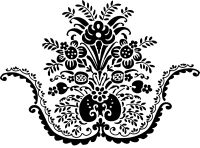
Related
- The Barbarian Invasions. The Migration Period. (Historical Atlas)
- The Gallic and Gallo-Roman costume period. 3rd to 4th century
- Byzantine costume history. 5th to 6th century.
- Frankish Merovingian costume history. 4th and 5th century
- Carolingian Period 752-987. Reign of Charlemagne.
- The Carolingian Fashion Period 987 to 1270.
- Europe in the time of Charles the Great 768 – 814. (Maps, Places).
- The Corset and the Crinolin. Fashion history from Ancient until 19th century.
- 11th to 13th century. French fashion history.
- 11th to 13th century. German fashion history.
- 11th to 15th century. Caps and Hoods fashion.
- 13th century. French male fashion history.
- 14th century. German fashion history.
- 15th century. German male fashion history.
- 15th century. German female fashion history.
- 14th, 15th century. Italian fashion history.
- Eleanor of Aquitaine, Medieval Queen in the 12th century. Fashion history.
- Reigns of John and of Charles V. 1350 to 1380. (Medieval, Byzantine, Gothic)
- Reigns of Charles VI. and Charles VII. 1380 to 1461. (Medieval, Gothic, Burgundy)
- Headdresses of the 14th Century.
- Headdresses of the 15th century. The Hennin.
- Headdresses 15th century. The Reticulated Headdress.
- The Influence of the Crusaders to the French clothing. 13th to 14th century.
- The Knights Hospitallers. The First Crusade. 11th century.
- The Knights of the Teutonic Order of Knighthood. History of German Crusaders 12th century.
- The Crusades. The Knights Templar. Medieval military religious order. 12th century.
- Syria during the period of the crusades. Maps, Names, Places. Historical Atlas.
- Life-size warrior figures in full armor and equipment. Greek, Roman, Gallic, Merovingian, Carolingian.
- Armor in England from the 10th to the 18th century
- The Rise of Monachism. Monastic costumes history.
- The Romance of the Rose. The Art of courtly love.
- The Lady of Tournament delivering the Price.
- On the history of costumes. From Ancient until the 19th century.
Discover more from World4 Costume Culture History
Subscribe to get the latest posts sent to your email.

